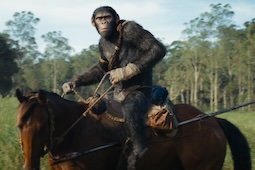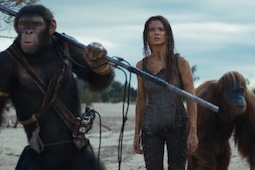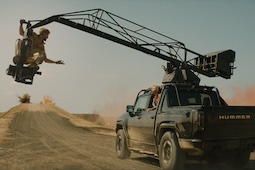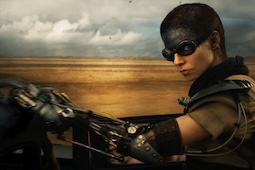
After 18 months of pandemic-related woes, it's heartening to have a movie that restores the integrity and awe of the theatrical experience. Denis Villeneuve's Dune is that movie, a lavishly staged adaptation of the first half of Frank Herbert's novel.
We've selected five sequences that emphasise Villeneuve's fidelity to the cinematic experience, sequences that could only work on a cinema screen with crystal-clear images and all-encompassing sound design.
1. Arrival on Arrakis
Villeneuve's sense of scale is, by now, well-established via the critically acclaimed likes of Arrival (2016) and Blade Runner 2049 (2017). As a director, he has a particular affinity for miniaturising his human subjects within the frame, establishing their vulnerability while at the same time crafting a tactile sense of wonder. Blade Runner's towering cityscapes, for example, strike a melancholy chord of humanity being steadily drowned out by the robotic and the artificial; in Arrival, Amy Adams' linguist is over-awed by the matter-of-fact positioning of a bizarre, egg-shaped spaceship.
In Dune, Villeneuve goes all out to convey the hulking space fleet of House Atreides, best emphasised when they leave their home planet of Caladan and arrive on Arrakis. The notion of human beings as pawns in a wider intergalactic chess game is magnificently well-evoked, and the scuffed, dirtied design of the ships meshes well with the attention to detail in the costumes. Add to this the inherent wind-blown atmosphere of Arrakis and Hans Zimmer's bagpiping score, and we're engulfed by both visual awe and dread portent.
That said, the scene finds its human centre in Timothée Chalamet's Paul Atreides, scaling down to an intimate level as he perceives the Fremen chant designating him as the 'lisan al Gaib' (prophet). Villeneuve's ability to convey complex information on both a macro and micro level arrests our attention throughout the movie.
2. Spice harvester devoured
Expectations were high for Villeneuve's initial reveal of Shai-Hulud, and the new Dune movie doesn't disappoint. This was, arguably, one of the few scenes nailed by David Lynch in his controversial 1984 adaptation of Dune, but Villeneuve has all manner of 21st-century craft, not to mention Zimmer's score, at his disposal.
Once again, spatial awareness and scale are key as the various characters are, to begin with, framed against the ornithopter and the spice harvester. When we perceive how large these objects are on their own terms, we gain a greater appreciation of how vast the sandworm truly is, increasing the sense of agonising suspense and terror. In contrast to Lynch's stately, distanced interpretation of the scene (largely dictated by the 1980s effects), Villeneuve is again able to emphasise close-up intimacy amidst a frenzied sequence, capturing Paul and Gurney Halleck's (Josh Brolin) visible reaction to the emergence of Shai-Hulud.
It brings relatable humanity to a fantastical scenario, further accentuated by a superb Zimmer score, which with its eerie vocal incantations, aims not for terror but majestic, awestruck beauty.
3. Attack on Arrakeen
Villeneuve's direction fuses with the acting, Zimmer's churning score, Greig Fraser's cinematography, Jacqueline West's costumes and Patrice Vermette's production design in the pivotal sequence where the Harkonnens betray House Atreides. There's a palpable sense of hand-made craft that fuses seamlessly with the more overt CGI effects – once again, if we can perceive the texture of the film's world, it helps us believe in the emotional consequences more readily.
The grandstanding, operatically emotional moments really resonate, particularly when the doomed Duke Leto (Oscar Isaac) embarks on a last-ditch attempt to destroy his nemesis, Baron Harkonnen (Stellan Skarsgard). Villeneuve also demonstrates his sure hand on the book's themes. By going in for a close-up on the burning palm trees, a sacred Arrakeen symbol now cruelly lost to fate, Villeneuve emphasises the novel's darker undertones of ecological exploitation and the cruelty towards nature.
Dune is, in every way, a movie painted as an epic portrait, even (somewhat paradoxically) in the intimate, seemingly casual moments.
4. Sandstorm escape
The layered sound design of Dune comes to the forefront in the sequence where Paul and his mother, Lady Jessica (Rebecca Ferguson) are forced to escape the Sardaukar in an ornithopter. By this stage, we're used to the movie engulfing us with its visuals and music, but the more objective, concrete sound elements of raging winds and sands are just as important in establishing the residual character of Arrakis. The sandstorm escape is one of the best scenes in the movie for showing how an audience can be overwhelmed in the best possible sense.
And yet, as already mentioned, it's not just spectacle for the sake of it. With visions portending his future, Paul learns to 'free-style' the aircraft, navigating through the storm and saving the lives of both him and his mother in the process. The beautiful, shimmering synth work from Zimmer as the dust cloud clears (reminiscent of Vangelis' work on the original Blade Runner) is one of many layers in the aural design that suggests wispy grains of sand floating in the Arrakis ether. And the close-ups during the crash landing are enough to get us on edge.
5. Shai-Hulud emerges
The spice harvester sequence was merely an entreé for the most important Shai-Hulud scene in the movie. This is perhaps the best scene in the film for demonstrating Villeneuve's all-encompassing sense of scale, highlighting Paul and Lady Jessica's fragility against the might of the Arrakis ecosystem. Villeneuve took over a year to nail the design of the sandworms and one can sense that he holds the focus on Shai-Hulud in order to demonstrate this level of commitment, allowing us an unprecedented close-up look at the worm in a way that David Lynch could only have dreamed of.
As ever, this sequence is but a portent of things to come in Dune: Part Two, due for release on 20th October 2023. There almost seems to be an implicit understanding between pint-sized Paul and the vast sandworm gazing back at him, which portends his eventual transformation into the Fremen 'mahdi' (saviour) and his command over the worms' behaviour. All that aside, on its own terms, the sandworm sequence demonstrates how Villeneuve maximises every nuance of the visual imagery and sound design to provide a memorable, gargantuan cinematic experience.
Has our list made you want to watch Dune again on the big screen? Then click here to book your tickets for Dune. Don't forget to tweet us your favourite moments from the movie @Cineworld.













.jpg)
.png)



